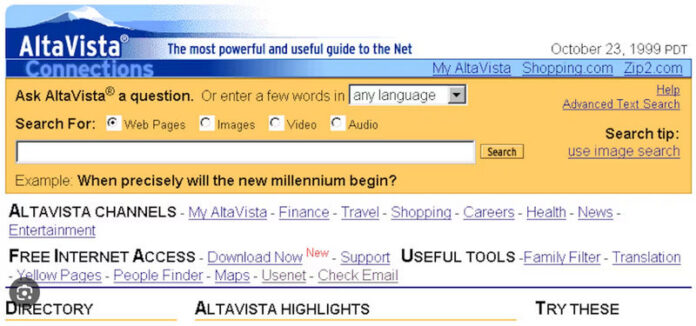Before Google became synonymous with web search, there were several powerful search engines attempting to organize and retrieve information efficiently. One such platform was AltaVista, an early pioneer that gained immense popularity during the 1990s and early 2000s. However, despite its initial success, AltaVista eventually faded into oblivion. In this article, we will explore the evolution of AltaVista as a search engine, discussing its rise, key features, and the reasons behind its decline in popularity.
- The Birth of AltaVista: In December 1995, Digital Equipment Corporation launched AltaVista as one of the first web search engines, utilizing a crawler-based method to index millions of web pages. Unlike its competitors, AltaVista prioritized content over advertisements or sponsored links. This approach resonated well with users who were seeking precise and relevant search results.
- Innovative Features of AltaVista: a) Advanced Search Technology: AltaVista possessed impressive indexing capabilities, enabling users to search through large volumes of information rapidly. It employed complex algorithms, including Boolean searches and phrase matching, giving users a more precise and customizable search experience. b) Multilingual Support: AltaVista was among the initial search engines to provide language-specific search capabilities. By offering various language options, it expanded its user base worldwide. c) Multimedia Search: While other search engines primarily focused on text-based webpages, AltaVista pioneered multimedia search by indexing images, audio files, and video content. This diversification enriched users’ search experience and set AltaVista apart from the competition.
- Acquisition by Yahoo and Decline in Popularity: a) Yahoo Acquisition: In 2003, Yahoo acquired AltaVista as part of its strategy to expand its search capabilities. Unfortunately, this transition marked the beginning of AltaVista’s decline. Yahoo failed to provide adequate support and investment to enhance the search engine’s technology and user experience as the focus primarily shifted to Yahoo’s main search engine. b) Competition from Google: As AltaVista began to falter, the emergence of Google’s superior search algorithm, PageRank, tipped the scales in favor of the new giant. Google’s simplicity, speed, and uncanny ability to deliver highly relevant search results made it a force to be reckoned with.
- Technological Limitations: a) Slow and Inefficient: AltaVista’s popularity began to wane due to its increasingly lethargic response times. The rapidly expanding internet overloaded AltaVista’s servers, rendering it slow and sometimes unreliable. This inability to cope with increasing internet demand further led users to explore alternatives. b) Spam-Filled Results: As the internet grew, so did junk and irrelevant content. AltaVista struggled to filter out spammy or low-quality results, leading to a deterioration in the quality of search results. Users searching on AltaVista often encountered irrelevant and spam-filled pages, eroding trust and loyalty.
- The Rise of Google: a) Reliability and Speed: Google’s minimalist design and faster search results quickly garnered users’ attention. Its search algorithm, PageRank, based on link analysis, provided more reliable and relevant search results compared to AltaVista’s algorithms. b) Adapting to a Changing Landscape: In contrast to AltaVista’s focus on content, Google began integrating advertising as part of its search engine in a more seamless and less intrusive manner. This allowed Google to monetize its platform while offering users an uncluttered search experience.
- Conclusion: AltaVista’s journey from a revolutionary search engine to near-obscurity teaches us valuable lessons about the ever-evolving realm of online search. Despite its innovative features and early market dominance, AltaVista fell victim to Yahoo’s misguided management and Google’s unmatched focus on user experience, speed, and relevancy. Today, AltaVista’s name lives on only as a nostalgic reminder of a search engine that paved the way for the digital landscape we know today.
While AltaVista’s decline can be attributed to various factors such as slow response times, lack of technological advancements, and increased competition, it reminds us of the importance of constantly adapting and reinventing to retain relevance in the world of technology.

